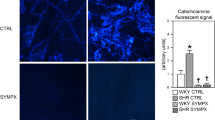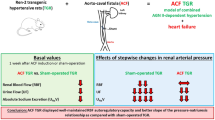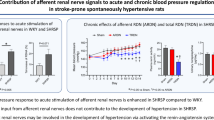Abstract
Okamoto and Aoki1 have reported the separation of a strain of Wistar rats which exhibit spontaneous hypertensive cardiovascular disease. Some of these animals (F8 by their lineage) have been placed at my disposal, and I have confirmed the occurrence of hypertension in their offspring. I have also determined the activity of the reninangiotensin system in the kidney by three different methods2. The left kidney was grafted on to a rat nephrectomized bilaterally 24 h previously and anæsthetized with pentobarbital sodium (40 mg/kg, intraperitoneally). Pressor activity of the renal venous effluent (renin release) was determined by the pressor response after graft with a definite period (10 min) of interruption of the blood supply to the kidney. The opposite kidney was kept frozen. Pressor activity of the crude extract (renin content) was also determined by injecting it into the bilaterally nephrectomized assay rat. The extract was then acidified to pH 3.0, and incubated at 0° C for 30 min to remove angiotensinase. Various amounts of the pre-treated extract were diluted to 1 ml. and incubated with an equal volume of non-hæmolysed rat plasma and M/15 phosphate buffer (pH 6.5) containing 0.002 per cent of thimerosal and 10−5 M of ethylenediamine tetraacetic acid at 37° C for 10 min. The angiotensin thus formed was determined by its pressor action in the rat anæsthetized with pentobarbital sodium (50 mg/kg, intraperitoneally) and treated with pentolinium tartrate (5 mg/kg, intravenously). The reaction constant (K) was calculated to express the angiotensin-forming activity of renin in the kidney extract.
This is a preview of subscription content, access via your institution
Access options
Subscribe to this journal
Receive 51 print issues and online access
$199.00 per year
only $3.90 per issue
Buy this article
- Purchase on Springer Link
- Instant access to full article PDF
Prices may be subject to local taxes which are calculated during checkout
Similar content being viewed by others
References
Okamoto, K., and Aoki, K., Jap. Circulation J., 27, 282 (1963).
Sokabe, H., Mikasa, A., Yasuda, H., and Masson, G. M. C., Circulation Res., 12, 94 (1963).
Sokabe, H., and Grollman, A., Amer. J. Physiol., 205, 264 (1963).
Masson, G. M. C., Experientia, 18, 243 (1962).
Aoki, K. (personal communication).
Author information
Authors and Affiliations
Additional information
An erratum to this article is available at https://doi.org/10.1038/206667e0
Rights and permissions
About this article
Cite this article
SOKABE, H. Renin-angiotensin System in the Spontaneously Hypertensive Rat. Nature 205, 90 (1965). https://doi.org/10.1038/205090a0
Published:
Issue Date:
DOI: https://doi.org/10.1038/205090a0
Comments
By submitting a comment you agree to abide by our Terms and Community Guidelines. If you find something abusive or that does not comply with our terms or guidelines please flag it as inappropriate.



